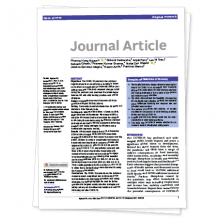Journal article
Apr 13 2017

Estimates of the quality of complementary feeding among Vietnamese infants aged 6-23 months varied by how commercial baby cereals were classified in 24-h recalls (Nguyen, T., 2015. Global Public Health)
The World Health Organization's (WHO) standardized questionnaire for assessing infant and young child feeding practices does not include commercial baby cereals (CBC), which are derived from several food groups and are fortified with micronutrients.
Journal article
Apr 01 2017

Social franchising and a nationwide mass media campaign increased the prevalence of adequate complementary feeding in Viet Nam: a cluster-randomized program evaluation (Rawat R., 2017. Journal of Nutrition)
Alive & Thrive (A&T) applied principles of social franchising within the government health system in Viet Nam to improve the quality of interpersonal counseling (IPC) for complementary feeding (CF).
Journal article
Sep 01 2016

Changes in knowledge, attitude and involvement of fathers in supporting exclusive breastfeeding: A community-based intervention study in a rural area of Viet Nam (Bich TH., 2016. International Journal of Public Health)
A one-year intervention in Viet Nam sought to understand how fathers’ knowledge, attitudes, and involvement in supporting exclusive breastfeeding (EBF) might change after receiving breastfeeding education materials and counseling services.
Journal article
Aug 31 2015

Maternal willingness to pay for infant and young child nutrition counseling services in Viet Nam (Nguyen, P.H., 2015. Global Health Action)
Alive & Thrive (A&T) Viet Nam, developed and incorporated elements of social franchising into government health services to provide high-quality nutrition counseling services to improve infant and young child feeding (IYCF) practices.
Journal article
Dec 01 2014

Incorporating elements of social franchising in government health services improves the quality of infant and young child feeding counselling services at commune health centres in Viet Nam (Nguyen, P.H., 2014. Health Policy and Planning)
This study assessed the effects of incorporating social franchising on infant and young child feeding (IYCF) counseling facilities and services.
Journal article
Oct 01 2014

Program impact pathway analysis of a social franchise model shows potential to improve infant and young child feeding practices in Viet Nam (Nguyen PH., 2014. Journal of Nutrition)
By mapping the mechanisms through which interventions are expected to achieve impact, program impact pathway (PIP) analysis lays out the theoretical causal links between program activities, outcomes, and impacts.

